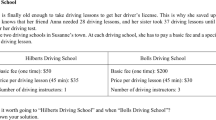Abstract
The development of multiple solutions for a given problem is important for learning mathematics. In the present intervention study, we analyzed whether prompting students to construct multiple solutions (more precisely: prompting them to apply multiple mathematical procedures to real-world problems) and prior self-efficacy influenced students’ self-efficacy directly as well as indirectly via perceived competence. Students’ self-efficacy (N = 304) was measured before and after a 4-lesson teaching unit, and students’ perceived competence was measured during the unit. Results of the path model showed that although prompting multiple solutions did not positively affect self-efficacy, indirect effects of teaching method on self-efficacy were found. Students who were asked to develop multiple solutions perceived higher competence and reported higher self-efficacy than students who were required to provide one solution. These indirect effects were significant for students with low prior self-efficacy and nonsignificant for students with high prior self-efficacy, indicating the moderating effect of prior self-efficacy. This finding indicates that students with unfavorable learning prerequisites such as low self-efficacy might benefit from teaching methods that require them to construct multiple solutions. Further, students with low prior self-efficacy reported lower competence during the lessons regardless of whether they were asked to develop one or multiple solutions; they also reported lower self-efficacy at posttest prior self-efficacy was controlled for. Our findings therefore indicate that disadvantages for students with low prior self-efficacy for the further development of self-efficacy during learning might be balanced by teaching students to construct multiple solutions.





Similar content being viewed by others
Notes
In addition, we applied a bootstrapping procedure (5000 bootstrapped samples) to analyze the significance of indirect and interaction paths, as the distribution of product terms might be only asymptotically normal (MacKinnon, Lockwood, & Williams, 2004). The p values for the effects under investigation were identical or even lower than when using the type = MLR analysis.
References
Achmetli, K., Schukajlow, S., & Krug, A. (2014). Effects of prompting students to use multiple solution methods while solving real-world problems on students’ self-regulation. In C. Nicol, S. Oesterle, P. Liljedahl, & D. Allan (Eds.), Proceedings of the joint meeting of PME 38 and PME-NA 36 (Vol. 2, pp. 1–8). Vancouver: PME.
Bandura, A. (1993). Perceived self-efficacy in cognitive development and functioning. Educational Psychologist, 28(2), 117–148.
Bandura, A. (2003). Self-efficacy: The exercise of control (6th ed.). New York: Freeman.
Blum, W. (2015). Quality teaching of mathematical modelling: What do we know, what can we do? In S. J. Cho (Ed.), The proceedings of the 12th international congress on mathematical education (pp. 73–96). Cham: Springer.
Blum, W., & Leiss, D. (2006). “Filling up” – the problem of independence-preserving teacher interventions in lessons with demanding modelling tasks. In M. Bosch (Ed.), CERME-4 – Proceedings of the fourth conference of the european eociety for research in mathematics education (pp. 1623–1633). Sant Feliu de Guíxols: Universitat Ramon Llull.
Boaler, J., & Selling, S. K. (2017). Psychological imprisonment or intellectual freedom? A longitudinal study of contrasting school mathematics approaches and their impact on adults’ lives. Journal for Research in Mathematics Education, 48(1), 78–105.
Bonney, C. R., Kempler, T. M., Zusho, A., Coppola, B. P., & Pintrich, P. R. (2005). Student learning in science classrooms: What role does motivation play? In S. Alsop (Ed.), Beyond cartesian dualism encountering affect in the teaching and learning of science (pp. 83–97). Dordrecht: Springer.
Butz, A. R., & Usher, E. L. (2015). Salient sources of early adolescents’ self-efficacy in two domains. Contemporary Educational Psychology, 42, 49–61.
Deci, E. L., & Ryan, R. M. (2000). The “What” and “Why” of goal pursuits: Human needs and the self-determination of behavior. Psychological Inquiry, 11(4), 227–268.
Gravemeijer, K., Bruin-Muurling, G., Kraemer, J.-M., & van Stiphout, I. (2016). Shortcomings of mathematics education reform in The Netherlands: A paradigm case? Mathematical Thinking and Learning, 18(1), 25–44.
Hannula, M. S., Bofah, E., Tuohilampi, L., & Metsämuuronen, J. (2014). A longitudinal analysis of the relationship between mathematics-related affect and achievement in Finland. In C. Nicol, S. Oesterle, P. Liljedahl, & D. Allan (Eds.), Proceedings of the joint meeting of PME 38 and PME-NA 36 (Vol. 3, pp. 249–256). Vancouver: PME.
Hänze, M., & Berger, R. (2007). Cooperative learning, motivational effects, and student characteristics: An experimental study comparing cooperative learning and direct instruction in 12th grade physics classes. Learning and Instruction, 17(1), 29–41.
Hiebert, J., Gallimore, R., Garnier, H., Givvin, K. B., Hollingsworth, H., Jacobs, J., … Stigler, J. (2003). Teaching mathematics in seven countries. In Results from the TIMSS 1999 video study. Washington, DC: NCES.
Hu, L., & Bentler, P. M. (1999). Cutoff criteria for fit indexes in covariance structure analysis: Conventional criteria versus new alternatives. Structural Equation Modeling, 6(1), 1–55.
Kline, R. B. (2005). Principles and practice of structural equation modeling. New York, NY: Guilford Press.
Levav-Waynberg, A., & Leikin, R. (2012). The role of multiple solution tasks in developing knowledge and creativity in geometry. Journal of Mathematical Behavior, 31, 73–90.
MacKinnon, D. P., Lockwood, C. M., Hoffman, J. M., West, S. G., & Sheets, V. (2002). A comparison of methods to test mediation and other intervening variable effects. Psychological Methods, 7(1), 83–104.
MacKinnon, D. P., Lockwood, C. M., & Williams, J. (2004). Confidence limits for the indirect effect: Distribution of the product and resampling methods. Multivariate Behavioral Research, 39(1), 99–128.
Marsh, H. W., Pekrun, R., Parker, P. D., Murayama, K., Guo, J., Dicke, T., & Lichtenfeld, S. (2017). Long-term positive effects of repeating a year in school: Six-year longitudinal study of self-beliefs, anxiety, social relations, school grades, and test scores. Journal of Educational Psychology, 109(3), 425–438.
Marsh, H. W., Pekrun, R., Parker, P. D., Murayama, K., Guo, J., Dicke, T., & Arens, A. K. (2018). The murky distinction between self-concept and self-efficacy: Beware of lurking jingle-jangle fallacies. Journal of Educational Psychology. https://doi.org/10.1037/edu0000281
Muthén, B., Muthén, L., & Asparouhov, T. (2016). Regression and mediation analysis using Mplus. Los Angeles, CA: Muthén & Muthén.
Muthén, L. K., & Muthén, B. O. (1998–2016). Mplus user’s guide (5th ed.). Los Angeles, CA: Muthén & Muthén.
Niss, M. (1996). Goals of mathematics teaching. In A. J. Bishop, K. Clements, C. Keitel, J. Kilpatrick, & C. Laborde (Eds.), International handbook of mathematics education (pp. 11–47). Dordrecht: Springer.
Niss, M., Blum, W., & Galbraith, P. L. (2007). Introduction. In W. Blum, P. L. Galbraith, H.-W. Henn, & M. Niss (Eds.), Modelling and applications in mathematics education: The 14th ICMI study (pp. 1–32). New York: Springer.
Pajares, F., & Miller, M. D. (1994). Role of self-efficacy and self-concept beliefs in mathematical problem solving: A path analysis. Journal of Educational Psychology, 86(2), 193–203.
Pantziara, M. (2016). Student self-efficacy beliefs. In G. A. Goldin, M. S. Hannula, E. Heyd-Metzuyanim, A. Jansen, R. Kaasila, S. Lutovac, P. Di Martino, F. Morselli, J. A. Middleton, M. Pantziara, & Q. Zhang (Eds.), Attitudes, beliefs, motivation, and identity in mathematics education (pp. 7–11). Heidelberg: Springer.
Pantziara, M., & Philippou, G. N. (2015). Students’ motivation in the mathematics classroom. Revealing causes and consequences. International Journal of Science and Mathematics Education, 13(2), 385–411.
Pekrun, R., Goetz, T., Frenzel, A. C., Barchfeld, P., & Perry, R. P. (2011). Measuring emotions in students’ learning and performance: The achievement emotions questionnaire (AEQ). Contemporary Educational Psychology, 36, 36–48.
Peugh, J. L., & Enders, C. K. (2004). Missing data in educational research: A review of reporting practices and suggestions for improvement. Review of Educational Research, 74(4), 525–556.
Rittle-Johnson, B., & Star, J. R. (2007). Does comparing solution methods facilitate conceptual and procedural knowledge? An experimental study on learning to solve equations. Journal of Educational Psychology, 99(3), 561–574.
Rittle-Johnson, B., Star, J. R., & Durkin, K. (2009). The importance of prior knowledge when comparing examples: Influences on conceptual and procedural knowledge of equation solving. Journal of Educational Psychology, 101(4), 836–852.
Schafer, J. L., & Graham, J. W. (2002). Missing data: Our view of the state of the art. Psychological Methods, 7(2), 147–177.
Schukajlow, S., & Krug, A. (2014). Do multiple solutions matter? Prompting multiple solutions, interest, competence, and autonomy. Journal for Research in Mathematics Education, 45(4), 497–533.
Schukajlow, S., Krug, A., & Rakoczy, K. (2015). Effects of prompting multiple solutions for modelling problems on students’ performance. Educational Studies in Mathematics, 89(3), 393–417.
Schukajlow, S., Leiss, D., Pekrun, R., Blum, W., Müller, M., & Messner, R. (2012). Teaching methods for modelling problems and students’ task-specific enjoyment, value, interest and self-efficacy expectations. Educational Studies in Mathematics, 79(2), 215–237.
Schukajlow, S., & Rakoczy, K. (2016). The power of emotions: Can enjoyment and boredom explain the impact of individual preconditions and teaching methods on interest and performance in mathematics? Learning and Instruction, 44, 117–127.
Schukajlow, S., Rakoczy, K., & Pekrun, R. (2017). Emotions and motivation in mathematics education: Theoretical considerations and empirical contributions. ZDM Mathematics Education, 49(3), 307–322.
Schütze, B., Rakoczy, K., Klieme, E., Besser, M., & Leiss, D. (2017). Training effects on teachers' feedback practice: The mediating function of feedbackknowledge and the moderating role of self-efficacy. ZDM Mathematics Education, 49, 475–489.
Silver, E. A., Ghousseini, H., Gosen, D., Charalambous, C. Y., & Font Strawhun, B. T. (2005). Moving from rhetoric to praxis: Issues faced by teachers in having students consider multiple solutions for problems in the mathematics classroom. Journal of Mathematical Behavior, 24(3–4), 287–301.
Usher, E. L., & Pajares, F. (2008). Sources of self-efficacy in school: Critical review of the literature and future directions. Review of Educational Research, 78(4), 751–796.
Usher, E. L., & Pajares, F. (2009). Sources of self-efficacy in mathematics: A validation study. Contemporary Educational Psychology, 34, 89–101.
Van Den Heuvel-Panhuizen, M. (2010). Reform under attack–forty years of working on better mathematics education thrown on the scrapheap? No way! In L. Sparrow, B. Kissane, & C. Hurst (Eds.), Shaping the future of mathematics Education: Proceedings of the 33rd annual conference of the Mathematics Education Research Group of Australasia (pp. 1–25). Fremantle, Australia: MERGA, Merga.
Verschaffel, L., Greer, B., & De Corte, E. (2000). Making sense of word problems. Lisse, the Netherlands: Swets and Zeitlinger.
Verschaffel, L., Van Dooren, W., Greer, B., & Mukhopadhyay, S. (2010). Reconceptualising word problems as exercises in mathematical modelling. Journal für Mathematikdidaktik, 31, 9–29.
Zan, R., Brown, L., Evans, J., & Hannula, M. S. (2006). Affect in mathematics education: An introduction. Educational Studies in Mathematics, 63(2), 113–122.
Zuffianò, A., Alessandri, G., Gerbino, M., Kanacri, B. P. L., Di Giunta, L., Milioni, M., & Caprara, G. V. (2013). Academic achievement: The unique contribution of self-efficacy beliefs in self-regulated learning beyond intelligence, personality traits, and self-esteem. Learning and Individual Differences, 23, 158–162.
Author information
Authors and Affiliations
Corresponding author
Rights and permissions
About this article
Cite this article
Schukajlow, S., Achmetli, K. & Rakoczy, K. Does constructing multiple solutions for real-world problems affect self-efficacy?. Educ Stud Math 100, 43–60 (2019). https://doi.org/10.1007/s10649-018-9847-y
Published:
Issue Date:
DOI: https://doi.org/10.1007/s10649-018-9847-y




